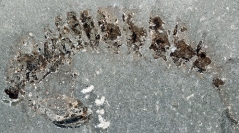

 Comptes Rendus Palevol
22 (2) - Pages 17-31
Comptes Rendus Palevol
22 (2) - Pages 17-31Mantis shrimps (Stomatopoda Latreille, 1817) are marine predatory crustaceans of the group Hoplocarida Calman, 1904 with an interesting, though incompletely known, evolutionary history. Here we introduce a new species of fossil mantis shrimps, Ostenosculda teruzzii n. gen., n. sp. from the Early Jurassic (Sinemurian) limestone formation of Osteno (Northern Italy). We present distinctive features that characterize the specimens as a new species, such as a unique arrangement of maxillipeds 2-5 (maxilliped 2 is the major raptorial appendage). We also present a phylogenetic systematic interpretation of the species based on the available features of morphology and body organisation. The unusual arrangement of the maxillipeds appears to represent a plesiomorphic condition relative to extant mantis shrimps: the maxillipeds are arranged in an almost straight anterior-posterior line, with rather large distances between them. This contrasts with extant forms and slightly younger fossils of about 150 million years old lithographic limestones (Late Jurassic) where further anterior maxillipeds are inserting far laterally and further posterior ones more medially, with very small distances between the next posterior ones. The herein studied specimens are the first of their kind to be confirmed for this period and geographical region and further close gaps in our understanding of the evolution of mantis shrimps.
Body organisation, Early Jurassic, Hoplocarida, raptorial appendages, Sinemurian, Stomatopoda, new genus, new species